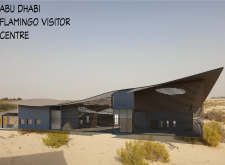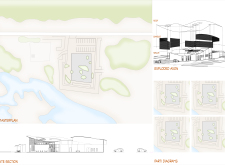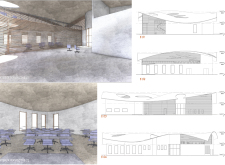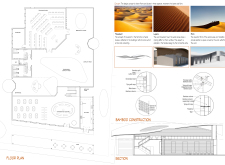5 key facts about this project
The Abu Dhabi Flamingo Visitor Centre is located within the desert landscape of Abu Dhabi, designed to accommodate both educational and recreational activities. The centre invites visitors to engage with the rich biodiversity of the area. The concept behind the design draws inspiration from sand dunes, highlighting three main elements: movement, layers, and form. These components work together to create an immersive experience that connects visitors to the natural environment.
Movement
The visitor centre features a roof structure that flows with a smooth, undulating shape. This design reflects the shifting nature of sand dunes and guides visitors as they move through the space. The roof serves not only as a striking visual element but also provides necessary shelter while maintaining a connection to the surrounding landscape.
Layers
Layering is a key aspect of the facade, where horizontal slats capture the subtle ripples made by wind on sand dunes. This element enhances the building's visual appeal by creating patterns of light and shadow throughout the day. The layered facade serves to bridge the interior and exterior, fostering a sense of unity with the environment.
Form
The structure's form is designed to embody the protective characteristics of sand dunes, creating a welcoming atmosphere for visitors. The gentle curves of the building mimic the shapes found in nature, allowing it to blend with the landscape. This thoughtful design prioritizes the experience of those who visit, encouraging them to interact with the space and surroundings comfortably.
Materiality
Bamboo is a significant material in the construction of the centre, emphasizing sustainability and the local context. The project utilizes bamboo split covers, lattice work, and bamboo columns. These choices not only support the building's structure but also contribute to an organic aesthetic. The use of bamboo reinforces the connection to the environment, enhancing the overall experience.
Inside, the spacious design allows natural light to fill the areas, creating a warm and inviting environment. The interaction between light and structure emphasizes key themes of movement and connection, drawing visitors deeper into the experience while showcasing the relationship between architecture and the desert ecosystem.





















































